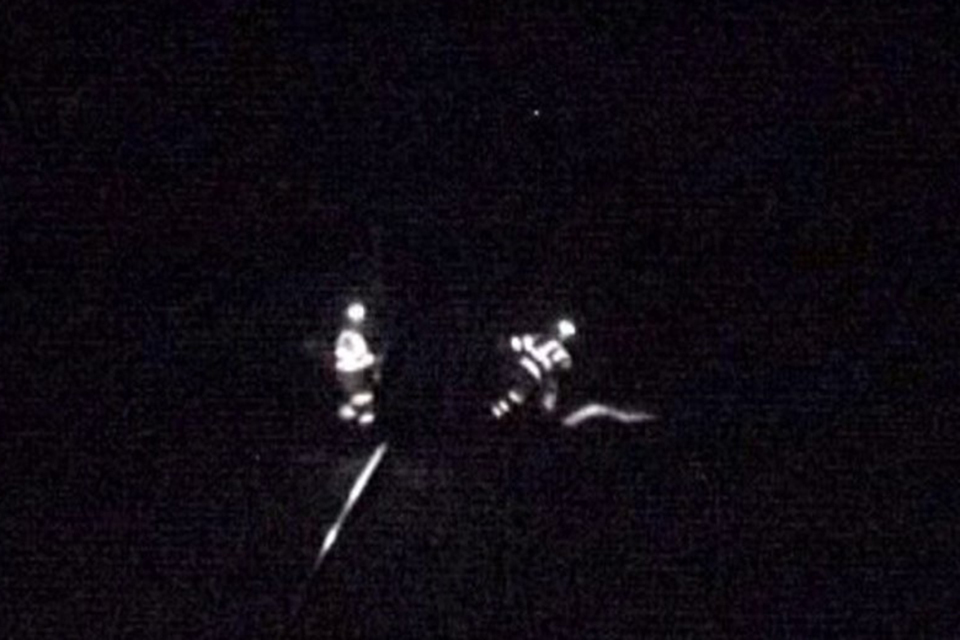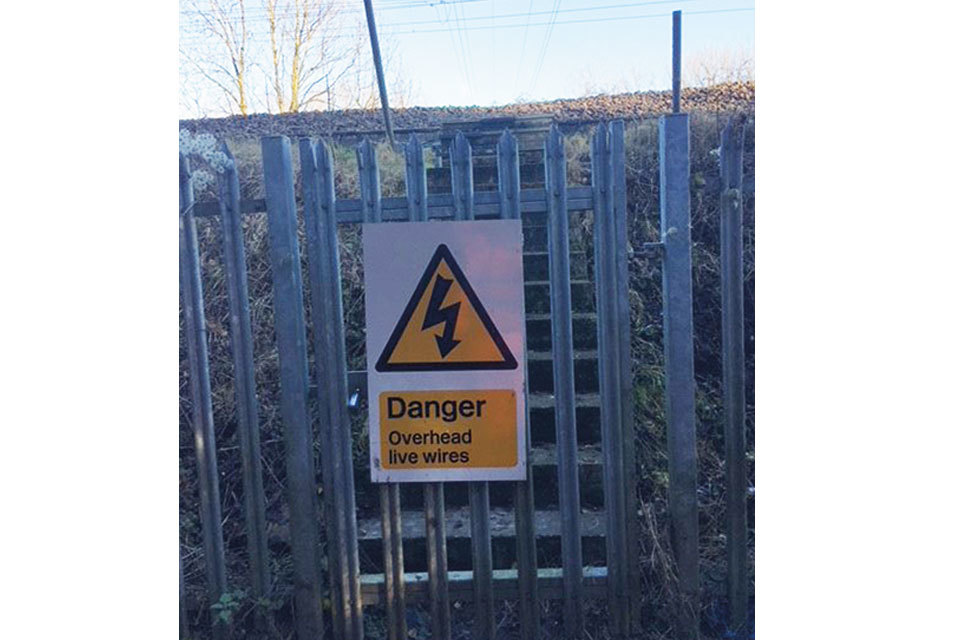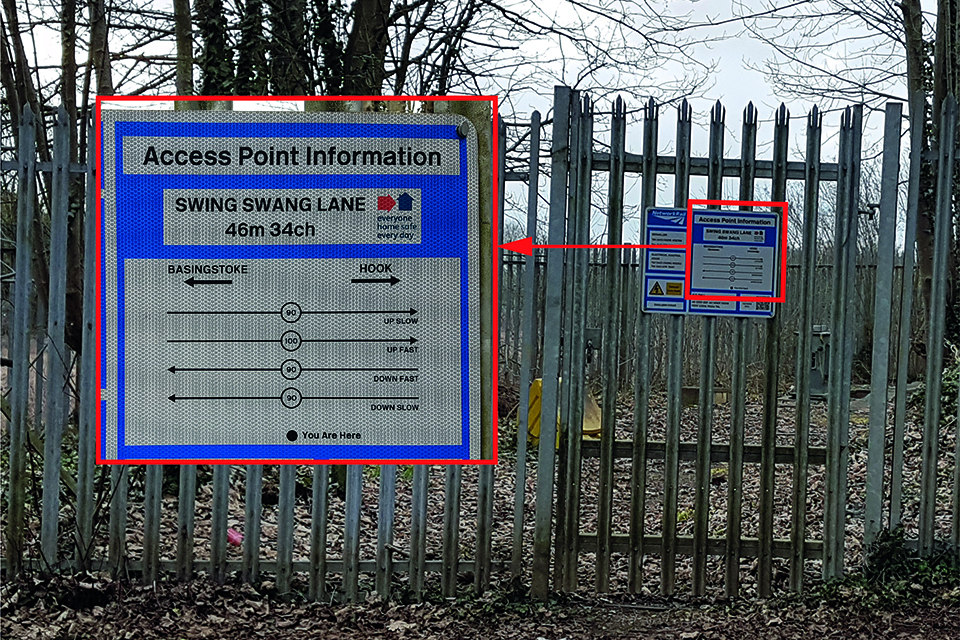Near miss with track workers at Sundon, Bedfordshire, 12 December 2018
Published 14 May 2019
1. Important safety messages
This incident demonstrates:
- the importance of providing signage so that staff can reliably identify access points, and the track layout relative to them. Recommendation 3 in RAIB report 15/2009 dealt with this specific issue
- the need for people responsible for the safety of others to have appropriate local knowledge of the area in which they are to work. Recommendation 3 in RAIB report 07/2017 dealt with this specific issue
- the need for staff to have mapping which helps them reach the correct access points from areas outside the railway boundary
- the potential for staff to become disorientated, particularly when travelling in the dark to work locations remote from safety briefing locations
- the importance of reaching a clear understanding during face to face safety critical communication
- the importance of sounding the warning horn, which on this occasion probably averted a fatal accident
2. Summary of the incident
At around 23:50 hrs on the night of 12 December 2018, two track workers narrowly avoided being struck by an express passenger train that was travelling at about 100 mph (161 km/h) on the Midland Main Line near the village of Sundon, Bedfordshire. The track workers quickly moved clear to avoid being struck, having been alerted to the train’s approach when the driver sounded the warning horn.
Forward-facing CCTV fitted to the train shows that the track workers were clear of the train’s path less than two seconds before it passed them. Although nobody was physically injured, both track workers and the train driver were left shocked.
The near miss occurred because the track workers were walking along a line open to traffic in the mistaken belief they were on a line which was closed to traffic. This confusion arose because the track workers had unintentionally accessed the railway at the wrong location for the planned work.

Forward-facing CCTV image showing track workers taking avoiding action less than two seconds before the train passed them (image courtesy of East Midlands Trains)
3. Cause of the incident
The two track workers were on the railway with the intention of applying earthing straps (part of the procedure for isolating the overhead electrical power supply) in preparation for signal gantry structural examinations later that night. One of the track workers was both the controller of site safety (COSS) and the ‘authorised person’ responsible for applying the earthing straps. The other was an earthing assistant whose role was to assist with the earthing activity.
Before accessing the railway, the two track workers had met with other track workers for work-related briefings at Leagrave station, located approximately 3 miles (4.8 km) by road from the location of the incident. These briefings were given by a ‘nominated person’ (the person in charge of arranging the electrical isolations required for the planned structural examinations at Sundon and for planned work at three other locations that night).
One of the nominated person’s briefings gave the COSS information about the work to be done[footnote 1]. There is conflicting evidence concerning the exact details that were given in this verbal briefing about accessing the railway. The paperwork collected by the RAIB after the incident was not signed by the COSS and included a hand-written note about using a footbridge to reach the access point. However, the COSS stated that this was not the same paperwork that he was given before the incident, which he signed and returned to the nominated person.
While at Leagrave station, the nominated person also gave the COSS the safe work pack which included details of the required isolation work and the railway lines that were closed to train movements[footnote 2]. It did not specify the access points to be used for the isolation work. It included a map showing some access points relative to railway features but did not show how these related to the road network. The mapping did not include the access point at the footbridge described by the nominated person, or the access point that was actually used by the COSS and earthing assistant.
Following the briefings at Leagrave station, the COSS and earthing assistant drove their cars past Sundon footbridge to the access point at Sundon substation. The COSS stated that they did this because this was the access point he had used the only other time he had worked in the Sundon area. The COSS checked the number of an overhead line structure that he could see against the structure numbers listed on his paperwork. He found that this access point was not in the area in which they were required to work.
The COSS and earthing assistant then turned their cars around and after travelling about 300 metres, drove back past Sundon footbridge. They did not notice an access point gate adjacent to the road at this footbridge, nor the access point gate described by the nominated person, which was on the opposite side of the railway. This was because the area was unlit, there were trees and bushes between the road and the railway, and the railway was at a higher level than the road and so obscured the view of the access point on the opposite side of the railway.
After driving for a further 600 metres, they came across another gated access point. This was at Water End Lane, but there was no signage at the access point stating this or giving the layout of the tracks at this location. The COSS again checked his paperwork and this time found the structures listed on his paperwork included one he could see near the access point.
The COSS and earthing assistant had been briefed at Leagrave station at a location on the up slow line side of the railway. Neither realised that during the car journey from Leagrave to Sundon they had driven underneath the railway and so both believed they were at an access point adjacent to the up slow line. However they were actually alongside the down fast line.

The access point used by the track workers (image courtesy of Network Rail)
The COSS then phoned the nominated person to say they had reached the access point. The nominated person told them they could start work and that when through the access point gate they should turn left; crossing the footbridge was not mentioned. Following this phone call, the COSS and earthing assistant unlocked the gate, turned left and began walking along the nearest railway line to locate the first structure listed on the paperwork. They believed they were walking along the up slow line, which was closed to trains, but they were actually walking in the opposite direction along the down fast line which was open to train movements at up to 125 mph (201 km/h).

Map showing intended route and actual route taken by the track workers
Within a few minutes they heard a train’s warning horn. Initially they thought the train was on another line, but when they turned around they immediately realised the train was approaching them on the line they were walking on. They both took immediate action to avoid being struck.
4. Previous similar occurrences and related actions
A collision between a passenger train and two rail-mounted grinding machines at Acton West, west London, on 24 June 2008 demonstrated the need for track layout information identifying individual railway lines at access points. The absence of such information at an access point being used when placing the grinding machines on the railway was one reason for them being placed on a line open to train movements, rather than on the intended line. Recommendation 3 of the resulting RAIB investigation (RAIB report 15/2009) stated that Network Rail should:
‘develop and implement a programme for the provision of track layout information signage at all railway access points, showing mileages, line names and directions and other key items of local railway information, as appropriate’.

An example of access point information signage (as fitted near Basingstoke)
Access point signage, including the access point name and track layout, has been fitted to some access points. However, Network Rail has stated that it does not intend to do this at all existing access points and, in 2010, informed the Office of Rail and Road (ORR, the safety regulator for Britain’s railways) that:
‘A cost benefit analysis had been carried out. It showed that it was not cost effective to retrofit signs at all access points. However it was considered that it would be cost effective to fit such signs at new build access points…Work is also underway, working with RSSB[footnote 3] to re-examine the requirements for signage at access points in the Group Standard’.
The relevant Group Standard about railway access signs originally issued in August 2008, and subsequently reissued as a railway industry standard (RIS) in December 2016, required access point signage until version 2 of RIS-3413-TOM was issued by RSSB in September 2018. Network Rail’s justification for not complying with the access point signage requirement in the previous version of this standard is included in a deviation recorded by RSSB[footnote 4]. This refers to the cost-benefit analysis and to an intention that access point information will be provided through hand-held devices. No timescale for achieving the use of hand-held devices for this purpose was given in the evidence supporting the deviation. However, the RAIB is aware that the widespread use of such devices was planned as part of a national initiative to introduce electronic permits to work, but this has yet to be implemented.
The importance of providing track layout information at access points was also highlighted by a near miss with track workers at South Hampstead station, north London, on 11 March 2018 (RAIB Report 20/2018). The absence of track layout information at the access point was one reason why staff wrongly identified the lines at an access point and so placed trolleys on a line open to train movements, instead of on the intended adjacent line which was closed to train movements. And, although not linked to the cause of the incident, the location information included in the safe work pack did not clearly show the site at the access point, and would not have assisted the staff on site to orientate themselves relative to the running lines. This was also the case with the information in the safe work pack given to the Sundon COSS.
In light of the serious nature of the Sundon and South Hampstead incidents, the RAIB wrote to the ORR on 29 March 2019 to express its view that there is a need for ORR to assess whether the actions taken by Network Rail in response to recommendation 3 of the Acton West investigation are sufficient.
The ORR has reported that it currently considers that Network Rail needs to do more to provide their staff and contractors with reliable information about access point location and track layout information. For this reason, ORR does not consider that Network Rail has fully implemented Recommendation 3 of the RAIB’s Acton West investigation and it continues to engage with Network Rail on this issue.
-
The earthing assistant was not at this particular briefing, and was not required to be. ↩
-
The pack should have been given to the COSS at least one shift before he was due to carry out the work to allow him to familiarise himself with the contents. There is no evidence that late provision of the pack influenced the near miss. ↩
-
A cross industry body formerly known as the Rail Safety and Standards Board. ↩
-
Search for 3413 at https://www.rssb.co.uk/standardscontent/deviations-register-pdf.pdf . ↩

